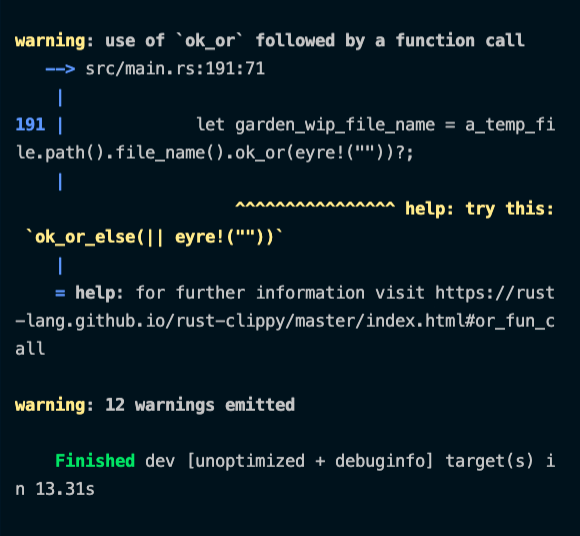Field Guide
Rust
A language empowering everyone to build reliable and efficient software.
Safer, faster programs
Rust’s industry-grade tools make collaboration fearless, allowing teams to focus on the tasks that matter.
Automation
Focus on the code that matters, leaving debates about semicolons in the past.
Rustfmt
Rustfmt automatically formats Rust code, making it easier to read, write, and maintain. And most importantly: never debate spacing or brace position ever again.
Clippy
Clippy builds on top of the Rust compiler to help you write more idomatic and efficient code.
Cargo Doc
Documentation tooling built-in to the cargo package manager removes the barriers to writing and shipping documentation.

Rustlings
Take a guided tour of the Rust programming language from
Learn the basics
Rust can be a very familiar langauge to people coming from JavaScript based backgrounds. Rustlings covers what you'll need to know to get up and running quickly.
Advanced Rust
Rustlings also touches on more advanced concepts such as threading that developers in other langauges might not have been familiar with before.
- Learning Rust by Working Through the Rustlings Exercisesin eggheadscreencastslanguagebeginner-friendly
- Referencing contiguous slices of data we don't own using rangein eggheadslicesrange
- Handling errors by unwrapping or early-returning with the `?` operatorin eggheaderror-handling
- Writing your first macroin eggheadmacros
A world of possibility
Build Discord bots, Serverless HTTP APIs, CLI tools for JS developers.
Discord
Rust's Serenity crate enables you to build async Discord bots with distributed tracing built-in.
Role Based Access Control
Group commands and restrict access to using them, or even seeing them in the automated help output, using highly customizable role based access control.
Collectors
Build rich user interactions by awaiting user input or reactions in the middle of control flow using collector streams.
Command Framework
Organize your code with the Serenity Command Framework. Build async hooks to execute before every message, bucket commands into rate-limited groups, and handle errors in command execution.
Integrations
What can you do with Rust?
From building CLI tools to serverless functions, from parsing markdown to running Discord bots, Rust can handle a wide array of applications.
Building a Rust CLI with subcommands using structopt and clap
Using structopt we can derive our arguments from an enum to generate subcommands.
Parsing Rust enums from JSON with Serde and tagged types
JSON, being untyped, can represent multiple types in the same field. Serde can parse these into Rust enums in a few ways.
Automatically Pinning Spotify listening party messages in Discord with Serenity
Are functions in Rust statements or expressions?
A key insight into the Rust language is what an expression is and that they return values in tail position, leading to 'implicit returns'.
On-Demand (lazy) inputs for incremental computation in salsa with file watching powered by notify in Rust
The Salsa crate allows us to trigger incremental computation through input chagnes. When paired with file watching, we can trigger regeneration of derived queries through file changes.
Checking for a minimum node version in Rust with Command
Rust's Command allows us to execute subcommands and gather the output easily allowing us to do things like check for a node version when building tools for JS devs.
Piping Rust code to rustfmt with configuration for shorter code examples in blog posts
You can pipe code directly to rustfmt when sharing code on different platforms (or your blog) to make it more readable for other people.
Custom Error types with Nom 5
Parsing can result in many application specific errors. Here's how to signal that when using the Nom parser-combinator library.
Serving HTTP over unix domain sockets with Tide
When building tools for JS devs, one way we can enable users to write JS that communicates with our Rust implementations is via sockets.
Concatenating two string slices &str in Rust
Using format! to concatenate two strings is idomatic Rust, even though it's not the absolute fastest way.
Sign up for my free newsletter
My newsletter is where you'll find exclusive content from me. I write about technology, startups, and why you shouldn't call yourself a junior engineer